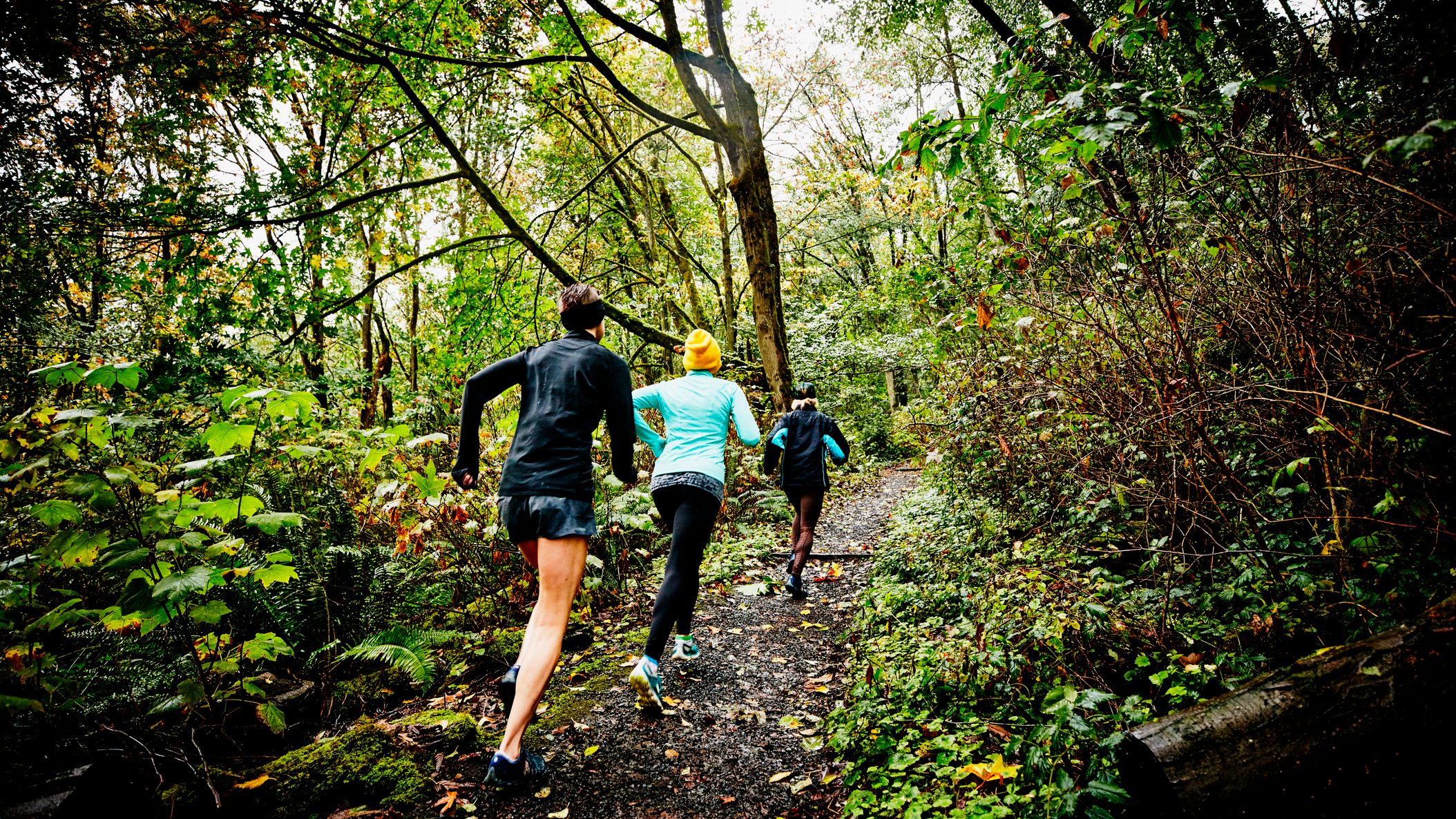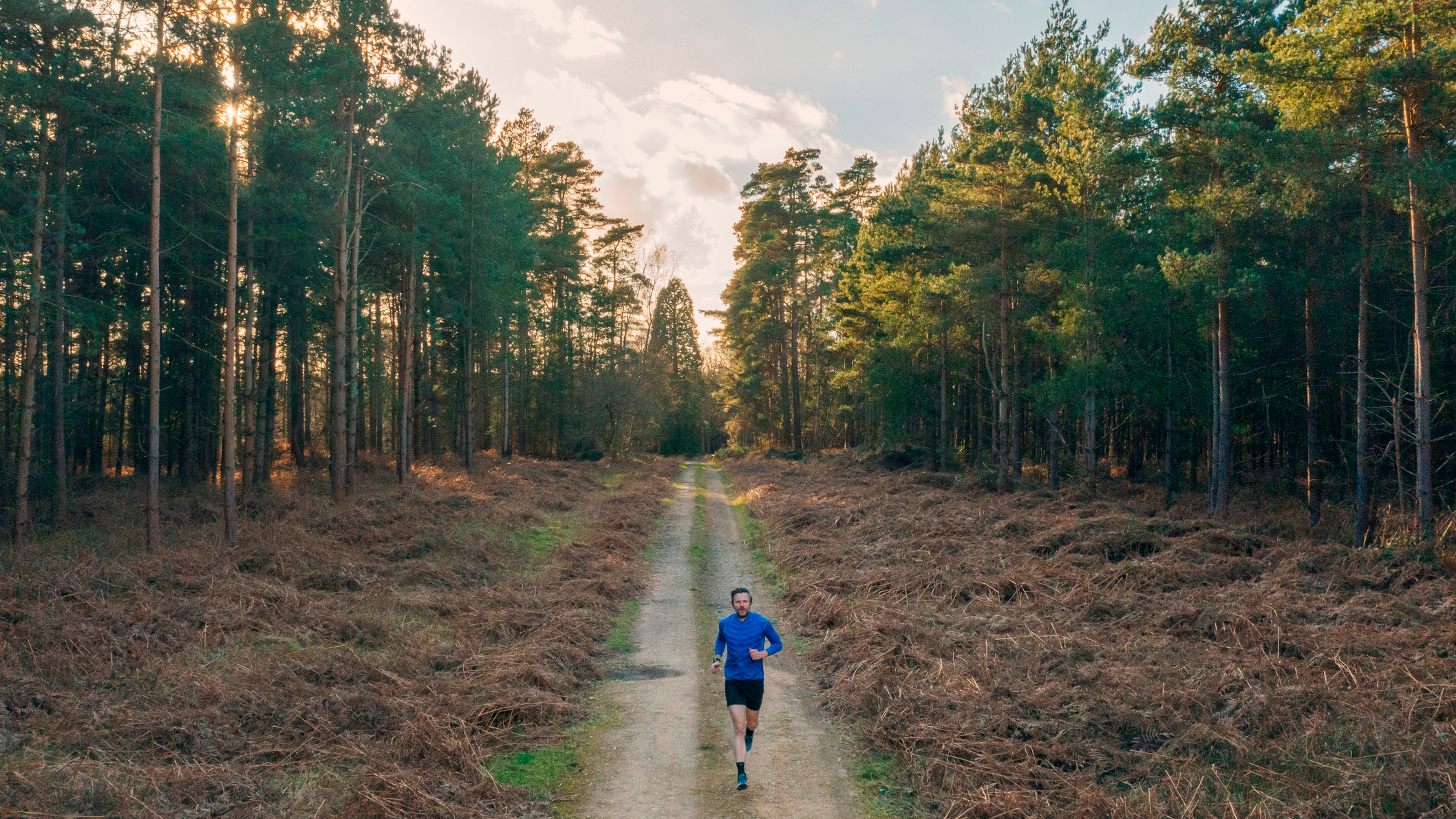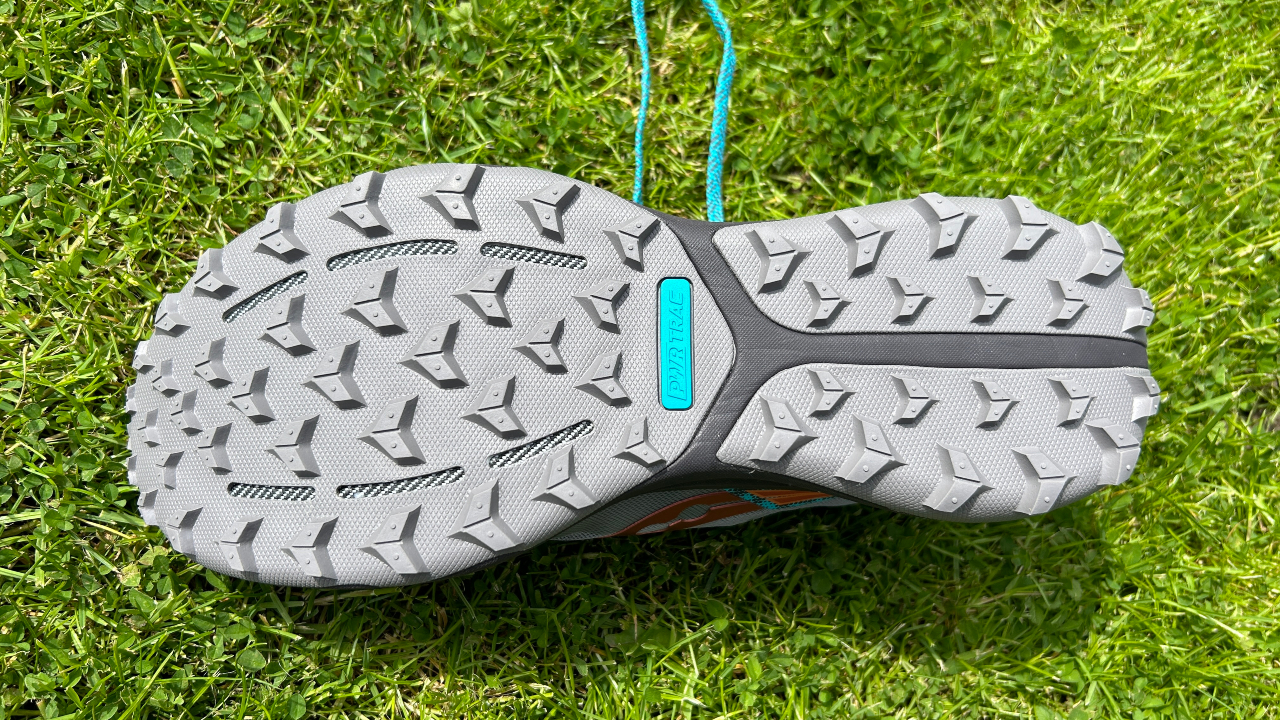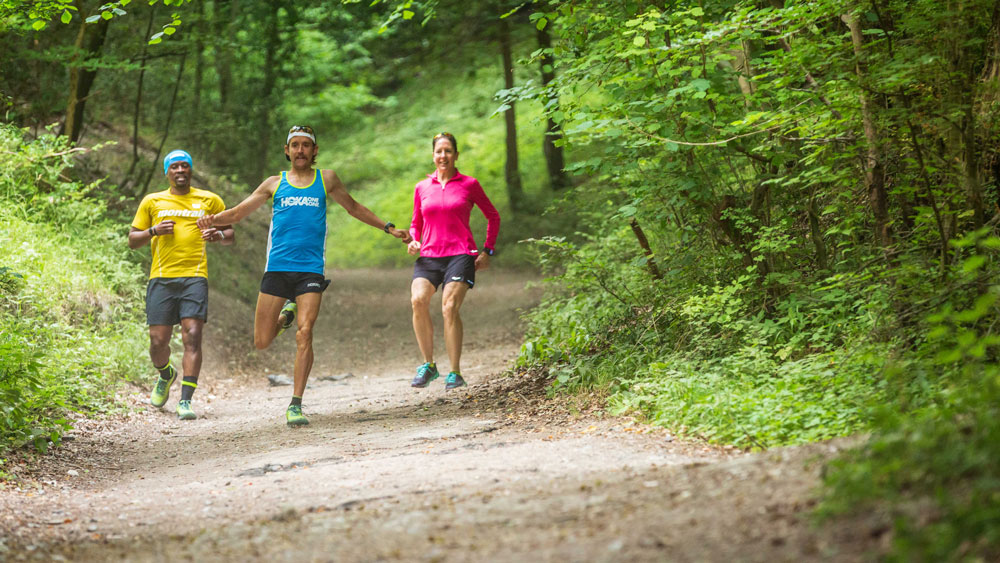How To Start Trail Running: Everything You Need To Know To Run Off-Road
Grab your (trail appropriate) shoes and get ready to off-road

As much as we love road and track running, if you’re a runner who never takes to the trails, you’re missing out. The change of scenery involved in swapping Tarmac for trails is not only easy on the eyes, it boosts your mental and physical health in new and different ways from road running.
However, if you’re completely new to trail running there are some things you need to consider before you head off-road. Below you’ll find a comprehensive guide to taking your first steps on the trails, complete with expert advice from ultramarathon runner and Garmin and Adidas Terrex ambassador Tom Evans.
The Benefits Of Trail Running
“For me there are three main reasons to start trail running,” says Evans. “One, the stress about pace goes. If you normally run at nine minutes per mile or whatever, on the trails that goes completely out of the window. It’s a bit harder to train on trails and a bit more unpredictable, but if it gets a bit tough you can stop and walk. It’s only going to be as hard as you make it.
“Secondly, the strength you develop is beneficial for every runner. That comes from running up hills, but also your ankle and foot strength increases from dealing with the different gradients and problems on the trail, like rocks or roots. That really makes you strong.
“Thirdly, it’s so good for your mind to get out of a busy city and away from cars beeping horns at you. Especially at that moment when you step onto the road to avoid running right past people. Out on the trails you don’t get any of that, you can completely relax.”

Trail-Running Shoes
On hard trails in the summer you might be fine in road shoes, but it’s worth picking up a pair of trail shoes, which are designed quite differently.
“One of the main differences is the outsole, the grip,” says Evans. “In the UK you probably do need specific trail-running shoes, because it’s often wet and it can be slippery in places. Trail-running shoes will afford you more grip so you’re a bit safer and you can enjoy your running more.
Sign up for workout ideas, training advice, reviews of the latest gear and more.
“Another difference is that they are a little but firmer and stiffer than a road shoe, which gives some extra protection to your feet, because you could step on sharp things like rocks.”

There’s an even greater degree of choice than with road running shoes because terrain can vary so dramatically. “Not all trail shoes are built the same,” says Evans. “Some are built for speed, some for mud, some for forest trails. So doing a bit of research is important.” Our guide to the best trail-running shoes is split by terrain so you can zero in on the most suitable pairs for where you’ll do the majority of your off-road running.
Once you’ve identified the kind of trail you’re going to spend the most time on, Evans also recommends thinking about the road shoes you like using.
“There will be a similar trail shoe to your road shoe,” says Evans. “Take what you like from the current trainer you’re using, then look for that in a trail shoe, and you’ll find something to suit you.”
Trail Running Technique
“Running on the road is almost like bike riding,” says Evans. “Every step is the same and you want to be metronomic. On the trails, you need to relax. It’s important to be able to adjust your steps and not worry about things like cadence or stride length. A lot of people focus on form and think ‘my arms should be doing exactly this’ or whatever, but you’re using your arms to balance. Keep your shoulders and arms relaxed, and the rest of your body will follow.
“On downhill running, instead of lengthening your stride, shorten your stride a little bit to land on your midfoot and forefoot to give yourself some extra stability. The worst thing you can do is land on your heel. It’s a smaller surface area and you’re more likely to slip or twist your ankle, because it’s not as stable.”

Running Uphill
The extra challenge will make you a stronger, better runner, but is there any way to make the big uphills easier? “Physically you have to practice,” says Evans. “The more time you spend running up hills the better you’re going to get at it.”
Keep at it and we promise the hills will start to feel easier, but there is also technology that can help you, especially for pacing your uphill efforts wisely.
"Garmin’s ClimbPro feature helps, because you know how long the climb is going to be. A lot of people go out way too hard too early, then they struggle and when they get to the top they’re so tired they don’t get to enjoy the view.”
Having some knowledge of the climb you’re on is important, because you often won’t be able to see the top of the hill from where you are. Whether you get that knowledge using tech like ClimbPro, via careful route planning or just by asking people coming downhill the other way, it will help a lot.
“Take the Tour de France riders—they know every in and out, every corner, every gradient of every climb that they’re doing that day,” says Evans. “Knowledge is everything.”
Running With Poles
Using poles can make trail-running easier, especially when tackling steep uphills of especially long or multi-day events. We spoke to Simon James, running coach and founder of trail-running adventure company Run The Wild, to learn more about running with poles and get his advice on technique. You'll find more guidance from James in our expert's guide to running with poles.
“A key aspect to using poles if you're on anything flat to mildly uphill, is that you should be pushing from behind,” says James. “Where most people make a mistake is that they put the running poles in front of them to push, and that's a braking mechanism.
“When things get steeper, the next big tip is double poling. Both poles in front planted on the ground in front of you. The first phase of the movement when the poles go in front of you is the upward movement. It brings you up the slope. You step through past the poles still planted in the ground, and the final phase is then pushing you forward, so you still get that forward momentum.
“On uphills, have your hand through the loop on the pole or in the glove if it has one. This means that your forearm can be relaxed, you don’t have to grip the poles hard.
“On the downhills the poles go in front of you and you have to take your hand out of the loops, because if you fall you could get your thumb pulled back, or break your wrist because you just can't get your hands out of the loop, which is not good. Either have your hands on top of the poles, or on the handles.”
Planning Trail-Running Routes
Knowing where you’re going takes on greater importance when trail running. It’s one thing to get lost in your local town or city—it’s another thing entirely for it to happen in an isolated area.
“People can get lost, I’ve done it,” says Evans. “My top tip would be to take time to plan your route before you go out. There are some great mapping tools for that. On Garmin Connect you can use routes that are popular in that area, which lets you know it’s runnable because lots of people have run there before.”
Many running watches from various brands offer breadcrumb navigation, where you get a simple line and pointer to follow once you load a route on to the watch, while some of Garmin’s flagship watches have color maps for more detailed route guidance and the ability to create routes on the fly.
A lot of devices also offer a back-to-start feature that will point you in the direction of your starting point when you’re out on a run. Garmin calls this TracBack, and on some of its watches you can get it to create a new route for you back to your starting point, rather than just retracing your steps.
“Say you want to run for an hour. You get to half an hour and then click TracBack on the watch, which will take you back to the start the way you’ve come,” says Evans. “Or you can make the watch create a different route that will allow you to see a bit more of the area.”
Another great way to plan a route is to find a keen trail runner in the area and download their routes from a platform like Strava. If you can get hold of the .gpx file for the route, you can load this on to a compatible watch to get guidance on the run.

Safety When Trail Running
“If you are going out on your own, you should tell someone you’re going, send them a route, and say what time you’re planning on starting and finishing,” says Evans. “If I’m ever on my own on the trails I’ll always take my phone and make sure it’s fully charged. Safety is important and there are far too many stories of even experienced mountain runners and other athletes going out into the mountains or hills and things going wrong. And things can happen very quickly.”
Once again technology can help you. Strava users can share their live location with other people using the Beacon feature, and the same is true of Garmin devices compatible with its LiveTrack feature. The free what3words smartphone app (App Store and Google Play) is also a great way of helping people – and the emergency services—home in on your location if you’re in trouble.
Garmin’s Assistance feature also allows you to text an alert with your location to three pre-selected emergency contacts if you hold down the top left button for seven seconds until the watch buzzes three times.
Where To Go Trail Running In The UK
“We’re so lucky in the UK—the trails are so varied here,” says Evans. “I live in Loughborough where the local trails are great, and we have some big parks and forests to run, but I’m also just three hours from the Lake District. Probably my favourite run in the Lake District is the Fairfield Horseshoe. I’m also just over an hour from the Peak District, and my favourite run there would be anything from Edale so you’ve got a big climb to start with. Then it’s only two, three hours to Snowdon.
“When I started trail running I started on the South Downs, and that’s a great introduction to trail running. It will always be up there as one of my favourite places to run in the UK.”
Trail Running FAQs
For answers to some of the most common trail-running questions, we turned to Elsey Whyman-Davis and Ida-Sophie Hegemann, professional ultra-marathon runners and ambassadors for The North Face, as well as Tom Evans, who is an ambassador for Garmin and Adidas Terrex. Opinions from the pros are mixed for our first question.
Is trail running harder than road running?
“No! I think running a road marathon is harder mentally and physically,” says Whyman-Davis. “You have that one sustained pace that you want to hit—you’re a slave to the watch. Whereas mountain running is much more about running to feel. If you don’t feel good, you can just hold back for a bit. And there’s also recovery on the descents. You also have the distraction of being in a beautiful place. Even if I do badly, I never once had a mountain race I regretted doing, because of where it takes you and the people involved. It sounds cheesy, but it’s amazing.
“I’d say it’s harder, but it’s also more beautiful,” says Hegemann. “You have new challenges coming up every few miles. You’re on a hard uphill and think, “I’m at my limit, I can’t push any harder’, then maybe you hit a small downhill section or runnable section where it’s flat and you have a whole new energy. Other parts of your legs are being used. It’s different because there are so many varied challenges, so it’s harder for the mind and the body, but also more beautiful than road running.”
“I think they’re very different,” says Evans. “Road running is not as skillful. If you’ve got a good engine and good biomechanics, you can be a really good road runner. But for trail running, especially for ultra-distance trail running, there are so many more skills. Just because you can run fast doesn’t mean you can hike fast. And just because you can hike fast doesn’t mean you can run downhill fast. You need so many tools in your toolbox. To do a race like UTMB, you’ve got to have a massive toolbox with the best tools.”
How do you build muscle for trail running?
You need strong legs for trail running, and your strength training should be planned around hills, because both uphill and downhill running require a bit of muscle.
“If I was doing two strength sessions a week, I’d have one that’s predominantly focused on training for running downhill and one on training for uphill running,” says Evans. “They would be separated throughout the week so I wouldn’t do a hard downhill run followed by a downhill strength session. I might do a hard downhill run, and then the next strength session would be an uphill strength session. Then after I’ve done a hard uphill run I might do my downhill strength training.
“Downhill is all about your quads. It’s about time under tension and knee stability. Do eccentric work, like a rear foot elevated lunge, for example. You can start by doing it isometrically—just holding the position—so you’re getting maximum time under tension.
“For uphill, it’s all strength and power development, mostly from your posterior chain: your glutes, your hamstrings and your calves. Do regular squats, regular deadlifts and regular calf raises. I go pretty heavy—five sets of five reps would be typical.”
Do you need special shoes for trail running?
“For sure,” says Hegemann. “It’s really important for me that I can trust 100% my shoes and that I have good grip. If the shoe doesn’t fit perfectly you will get problems in every part of your body—your back, your knees. Shoes are the most essential bit of gear for trail running.”
“You definitely need a shoe that isn’t a road shoe,” says Whyman-Davis. “Even if it’s not that technical, you still need some traction and stability. Really you have to choose the shoe based on what it’s like underfoot. It’s not completely based on you, it’s based on the environment.”
What do you look for in a trail-running shoe?
“The choice of shoe depends on the terrain,” says Hegemann. “Sometimes I look for cushioning, sometimes grip, and most of the time it’s important that I can still feel the ground, so I don’t like the shoe to be too stiff.”
“Comfort is the priority for me,” says Whyman-Davis. “I like to feel very light on my feet, and I can't wear black shoes—I have to wear a color that makes me feel light and fast. If I wear a pair of black trainers, I feel like I’ve got bricks on my feet. Then it’s about having confidence, mainly when descending, knowing that you can rely on the shoe to have enough grip.”
What advice do you have for planning routes on the trails?
“I use the Coros app because you can just do it directly on the app and then I’ve got a Coros watch so it goes straight there,” says Whyman-Davis (who is also a Coros ambassador). “On Strava you’ve got the Heatmaps so you can see where people have been, because sometimes you plan a route somewhere and if you haven’t got anything on the Heatmap, the trail doesn’t really exist. There is officially meant to be a path there, but it doesn’t exist. Heatmaps on Strava show you where people go frequently so you know it’s a good trail. But it also means it’ll be busier. That’s not always a good thing, sometimes it’s nice to get off the beaten track.
“A really good app if you’re trail running when you don’t often have signal—and one that has actually saved my life—is Footpath. It works offline and you can see where you are and where the trails are. My headtorch went out on the top of a fell in the middle of winter last year, and Footpath helped me off the side of a mountain when I had nothing else. Without it I wouldn’t have known how to get off.”
“It’s good to not to start too long or too technical with your route,” says Hegemann. “Start with some small routes and you can add to them afterwards if you feel good. I always plan my routes with the Suunto app and then I have them directly synced to my watch [Hegemann is also a Suunto ambassador], so I know how much elevation I have, and also from the Strava Heatmap I can see how many runners ran there in the last weeks or months, so I know about the snow and mud conditions.”

Nick Harris-Fry is a journalist who has been covering health and fitness since 2015. Nick is an avid runner, covering 70-110km a week, which gives him ample opportunity to test a wide range of running shoes and running gear. He is also the chief tester for fitness trackers and running watches, treadmills and exercise bikes, and workout headphones.
